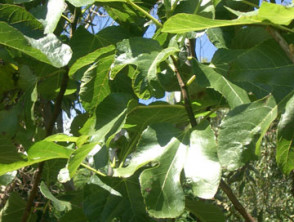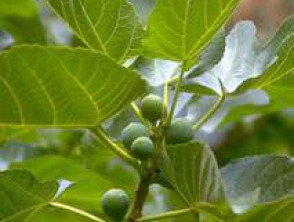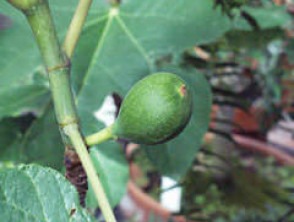| Common name: | Fig (English), Higo (Spanish), Figue (French), Feige (German), Fico (Italian). |
| Botanical name: | Ficus carica |
| Family: | Moraceae (Mulberry family). Division: Magnoliophyta, Class: Magnoliopsida, SubClass: Hamamelidae, Order: Urticales, Family: Moraceae. |
| Origin: | The fig is believed to be indigenous to western Asia and to have been distributed by man throughout the Mediterranean area. Remnants of figs have been found in excavations of sites traced to at least 5,000 B.C. |
| Description: | The fig is a picturesque deciduous tree, up to 15m tall, but more typically to a height of 3-10m. Their branches are muscular and twisting, spreading wider than they are tall. Fig wood is weak and decays rapidly. The trunk often bears large nodal tumors, where branches have been shed or removed. The twigs are terete and pithy rather than woody. The sap contains copious milky latex that is irritating to human skin. The bark is smooth and silvery gray. Fig trees often grow as a multiple-branched shrub. Fig leaves are bright green, single, alternate and large (to 25cm length). They are more or less deeply lobed with 1 to 5 sinuses, rough hairy on the upper surface and soft hairy on the underside. In summer their foliage lends a beautiful tropical feeling. The tiny flowers of the fig are out of sight, clustered inside the green fruits, technically a synconium. Pollinating insects gain access to the flowers through an opening at the apex of the synconium. |
Fig tree
| Uses: | Edible fruit. The milky juice has been used as a destructive treatment for warts and to cure skin infections. The juice of fig leaves has long been used to treat vitiligo (psoralen). |
| Allergens: | The furocoumarins psoralen, bergapten and the coumarins umbelliferone, 4',5'-dihydropsoralen and marmesin are present mostly in leaves and unripened fruit. |
| Allergy: | Phototoxic, not an allergy. Ingestion of the fruit apparently does not cause photosensitization. However, there are reports of anaphylaxis after eating figs; this may represent cross reaction with natural rubber latex. |
| Cross reactions: | Weeping fig (F. benjamina, an indoor plant). Also cross reacts with natural rubber latex so rubber latex allergic individuals need to take care. Related species: Cluster fig (Ficus racemosa), Sycomore Fig (Ficus sycomorus) |
| Other information: | The common fig bears a first crop, called the breba crop, in the spring on last season's growth. The second crop is borne in the fall on the new growth and is known as the main crop. |
Bullous dermatitis due to contact with fig tree


